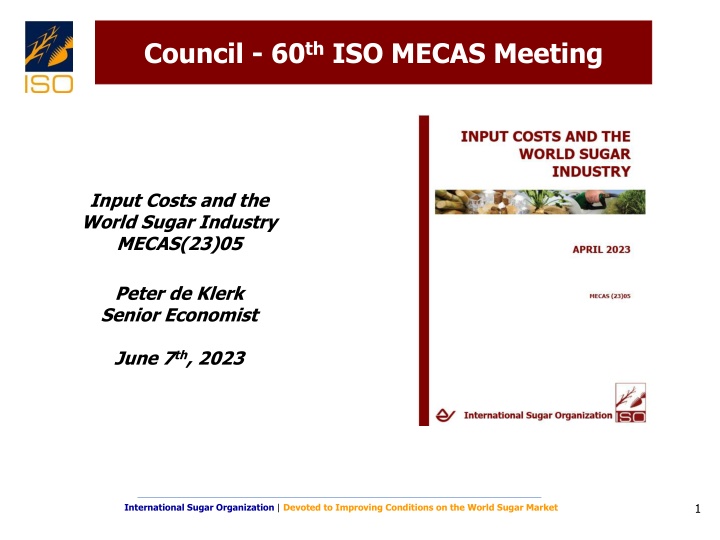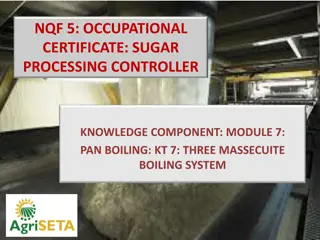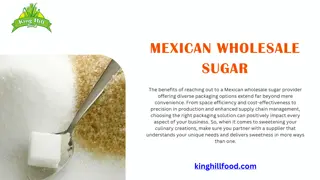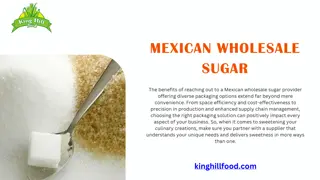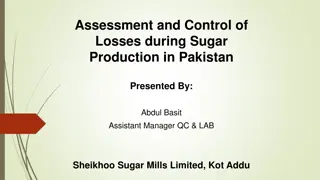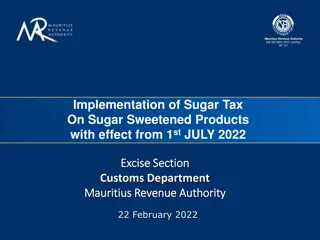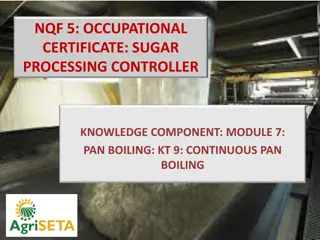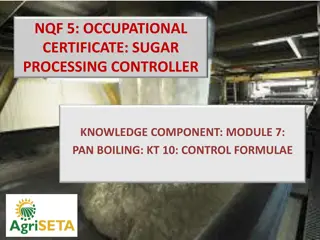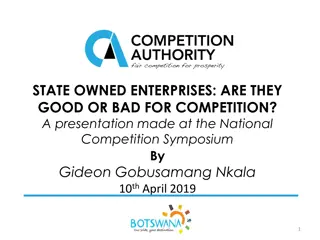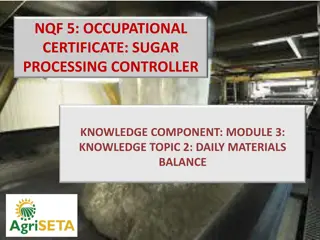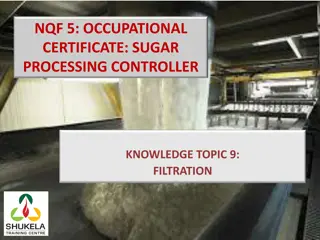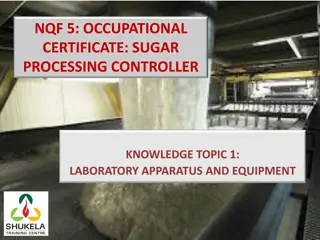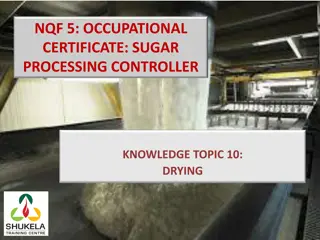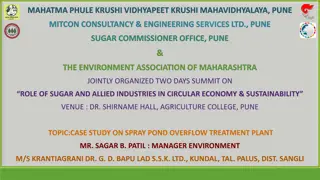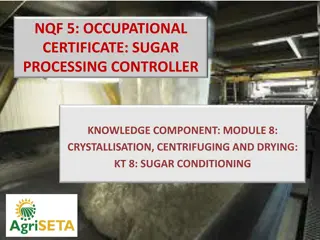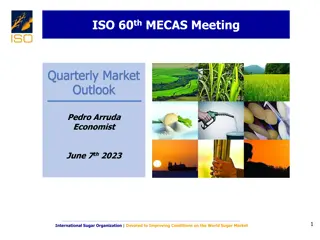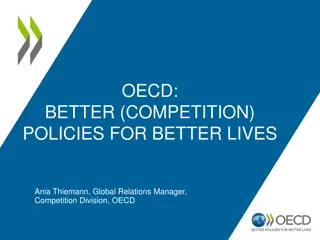Insights into the World Sugar Industry: Competition, Processing, and Agriculture Trends
Delve into the intricacies of the global sugar industry focusing on competition, processing, and agriculture aspects. Learn about the high-yielding crops, input costs, production dynamics, and planting techniques that shape the world sugar market. Gain valuable insights into sugarcane and sugarbeet cultivation, yield potentials, and the evolving landscape of sugar production worldwide.
Download Presentation

Please find below an Image/Link to download the presentation.
The content on the website is provided AS IS for your information and personal use only. It may not be sold, licensed, or shared on other websites without obtaining consent from the author.If you encounter any issues during the download, it is possible that the publisher has removed the file from their server.
You are allowed to download the files provided on this website for personal or commercial use, subject to the condition that they are used lawfully. All files are the property of their respective owners.
The content on the website is provided AS IS for your information and personal use only. It may not be sold, licensed, or shared on other websites without obtaining consent from the author.
E N D
Presentation Transcript
Council - 60th ISO MECAS Meeting Input Costs and the World Sugar Industry MECAS(23)05 Peter de Klerk Senior Economist June 7th, 2023 1 International Sugar Organization | Devoted to Improving Conditions on the World Sugar Market
Competition Agriculture Processing Introduction Input Costs Overarching characteristics Sugarcane and sugarbeet are high yielding crops Sugar cane and sugarbeet require a commensurate level of inputs Sugarcane and sugarbeet are very different ============================================================ Agriculture Processing Price and Competition 2 International Sugar Organization | Devoted to Improving Conditions on the World Sugar Market
Competition Agriculture Processing Introduction Overarching characteristics Sugarbeet and sugarcane are high yielding crops Sugarcane and beet yields Other arable crop yields 80 7 Maize 70 6 60 Rice, paddy Wheat Sugar cane 5 Tonnes / ha Tonnes / ha 50 4 40 Sugar beet 3 30 Barley 20 2 10 1 Soybeans 0 0 Oats Cane yields have under-explored potential Slow yield increase due to research / ratoon structure C4 photosynthetic pathway gives scope Beet yields adaptable to new science Diploid chromosome lends itself to gene-marking technology 3 International Sugar Organization | Devoted to Improving Conditions on the World Sugar Market
Competition Agriculture Processing Introduction Overarching characteristics FAO - World production of crops 2000 vs 2019 4,000 3,500 3,000 2,500 Mln tonnes 2,000 1,500 1,000 500 0 Sugar cane Maize Wheat Rice, paddy Oil palm fruit Potatoes Sugar beet Other 4 International Sugar Organization | Devoted to Improving Conditions on the World Sugar Market
Competition Agriculture Processing Introduction Planting / Husbandry / Irrigation Sugarbeet planting Sugarbeet is an annual crop Planting is mechanised with 12 or 24 rows set out 45-50 cm apart with a beet seed every 16 cm (about 100,000 120,000 plants per hectare) Seedbed should be prepared to a depth of 5-7cm with a high level of small particles (more than 30% of less than 3mm size) Planting operations need to limit ground impaction 5 International Sugar Organization | Devoted to Improving Conditions on the World Sugar Market
Competition Agriculture Processing Introduction Planting / Husbandry / Irrigation Sugarcane planting Sugarcane is a perennial crop Leadtime to first cut can be up to 18 months, usually including two rainy seasons Planting is mostly mechanical, rootstock can be prepared on-farm Preparations are key given multiple harvests, including fertilizer/mineral applications and best possible seed-stock selection Plant protection is key for early development, while row closures prevent interventions in latter stages High moisture environment is mostly beneficial rather than damaging 6 International Sugar Organization | Devoted to Improving Conditions on the World Sugar Market
Competition Agriculture Processing Introduction Planting / Husbandry / Irrigation Husbandry High yielding nature implies need to match crop requirements in order to achieve optimal output Beet plants need moisture and protection from predators Cane fields are very susceptible to weeds in early development stages and require integrated pest and disease management Applications of fertilizers (nitrogen) is key while potassium and minerals improve crop development Irrigation Can lift yields to above 100 tonnes/ha for both beet and cane Irrigation offsets seasonal dry weather period Precision irrigation, with fertigation, is useful in crops that close rows 7 International Sugar Organization | Devoted to Improving Conditions on the World Sugar Market
Competition Agriculture Processing Introduction Planting / Husbandry / Irrigation Beet growing costs Beet seeds increased to cover cost for new varieties Machinery costs increase due to higher fuel prices and field passes Fertilizer cost is directly-linked to the natural gas input cost in the urea production process Irrigation costs have increased due to higher water and power costs 8 International Sugar Organization | Devoted to Improving Conditions on the World Sugar Market
Competition Agriculture Processing Introduction Planting / Husbandry / Irrigation Cane growing costs PECEGE estimates the following profile for Brazil Fertilizer cost is the main element, and increased substantially in the last year Seedling cost is equivalent to lost sugar production Type Fertilizer pH correctors Herbicides Insecticides Seedlings Others *Assumes yield of 82.9 tonnes/ha Cost BRL/t 4.96 0.71 0.73 0.48 1.41 0.23 8.52 BRL/ha* 411.32 58.64 60.75 40.17 116.99 18.85 706.72 International Sugar Organization | Devoted to Improving Conditions on the World Sugar Market 9
Competition Agriculture Processing Introduction Planting / Husbandry / Irrigation Pivotal differences For beet, annual seed costs and field preparation are key For cane, the relatively low harvested-for-processing acreage is key (estimated at 85.7%) after allowing for 18-month development and production of seed material Urea Price in USD / KgN 2.5 Higher urea costs will have impacted both industries directly and equally USD / Kg of Nitrogen 2.0 1.5 1.0 0.5 0.0 Dec-19 Apr-18 Jan-17 Mar-21 Jan-22 Jul-19 Sep-18 Feb-19 Aug-21 Nov-17 May-20 Oct-20 Nov-22 Jun-17 Jun-22 10 International Sugar Organization | Devoted to Improving Conditions on the World Sugar Market
Competition Agriculture Processing Introduction Nitrogen Fertilizers For global warming, nitrous oxide is 273 times more impactive than carbon dioxide Nitrification of waterways New products include urease inhibitors and slow-release fertilizer coating The plant-growth phase between the 80th and 280th day of cane development is a key period for nitrogen supplements This phase in beet development is shorter due to autumnal weather and harvesting 11 International Sugar Organization | Devoted to Improving Conditions on the World Sugar Market
Competition Agriculture Processing Introduction Harvesting Beet harvesting is operationally different from cane harvesting 12 International Sugar Organization | Devoted to Improving Conditions on the World Sugar Market
Competition Agriculture Processing Introduction Mechanical harvesting Rows Either 6 or 12 rows Just one row Operation Lift, top and discard Cut, top, billet and discard Carrying Up to 10 tonnes of beet Offload at edge of field No carry capacity Tractor/trailer in tandem Transport No transfers, can be piled One more transfer, no delay Range 100km to factory 30km to mill 13 International Sugar Organization | Devoted to Improving Conditions on the World Sugar Market
Competition Agriculture Processing Introduction Harvesting Most cane and all beet are harvested mechanically Cane is harvested green in India, burning cane prior to harvesting remains traditional in many countries The global cane industry has progressed significantly since 2000 towards mechanical harvesting The first self-propelled beet harvester was used in 1974! 14 International Sugar Organization | Devoted to Improving Conditions on the World Sugar Market
Competition Agriculture Processing Introduction Labour / transport cost The sugarcane industry has a high rural economy development impact - In India, over 50 mln people depend on the cane industry - In Brazil, this figure is around 2.3 mln people Regular field work is required to obtain optimal yields; Non-mechanical harvesting adds another layer of labour costs Both inflationary and exchange rate pressures will have increased wages in 2022 With no infield processing, beet/cane transport is a large-tonnage operation. Only around 15% of the cargo is made into sugar-based products Road fuel cost rose sharply in 2022 15 International Sugar Organization | Devoted to Improving Conditions on the World Sugar Market
Competition Agriculture Processing Introduction Processing Plants Key insight Both sugarcane mills and sugarbeet factories cost around USD 100 mln for a 1 mln tonne annual beet/cane capacity. Biggest beet factory Vierverlaten, Netherlands (34,000 tonnes/day) Biggest cane mill Usina Sao Martinho, Brazil (48,000 tonnes/day) Input season Beet factories can operate using piled beets and thick juice storage, but processing seasons tend to be short at between 90 130 days Cane mills are dependent on constant supply from fields, operating up to 8-9 months of the year Operations Plants are split between cane/beet to thick juice and thick juice to sugar/ethanol processes. The second stage is similar to the operation of a destination refinery 16 International Sugar Organization | Devoted to Improving Conditions on the World Sugar Market
Competition Agriculture Processing Introduction Boiler Fuel Beet Factories Cost of steam input per tonne of sugar 600 500 US gas EU gas 400 Oil / Distillate Coal USD 300 200 100 - Jan-19 Jan-20 Jan-21 Jan-22 Jan-23 Apr-19 Apr-20 Apr-21 Apr-22 Jul-19 Oct-19 Jul-20 Oct-20 Jul-21 Oct-21 Jul-22 Oct-22 The cost of boiler fuel rose sharply during 2022 following the Russia- Ukraine conflict EU natural gas prices were significantly impacted Steam input cost into EU sugarbeet processing plants peaked at USD500/tonne of sugar, from a normal level of less than USD100/tonne Oil/distillate and coal has been a cheaper feedstock in the last 18 months 17 International Sugar Organization | Devoted to Improving Conditions on the World Sugar Market
Competition Agriculture Processing Introduction Boiler Fuel Cane Mills Bagasse cost to sugar mills is zero. Delivered to mill, no preparation required High pressure boilers, producing steam at up to 120 bar, can drive a turbine (to generate power), as well as provide the mill with steam and electricity Sales of energy into the electricity grid are countercyclical to hydropower, but tend to be perceived as sporadic by grid operators 18 International Sugar Organization | Devoted to Improving Conditions on the World Sugar Market
Competition Agriculture Processing Introduction Destination refiners Global sugar trade (65 mln tonnes) is mostly raw sugar (43 mln tonnes) Raw sugar requires re-processing at destination Destination sugar refineries have boilers that operate on fossil fuels No bagasse or other byproduct is available as a substitute The Dubai refinery is reported to use 2,450 MJ of energy per tonne of raw sugar input 19 International Sugar Organization | Devoted to Improving Conditions on the World Sugar Market
Competition Agriculture Processing Introduction Price dynamics amongst arables Competition for acreage is a historic and familiar concept Cereals and vegetable oil crops offered premiums over sugar in last 2 years Furthermore, sugar production is energy and cost-intensive Domestic price formulation mechanisms are stable but retrospective FAO Food Price Index 280 240 200 160 120 80 2021-01 2021-07 2022-01 2022-07 2023-01 FAO Food Index Cereals Veg Oil Sugar 20 International Sugar Organization | Devoted to Improving Conditions on the World Sugar Market
Competition Agriculture Processing Introduction Price mechanisms and cost absorption Assuming a 65/35 split between farmer and processor and a reliance on global market prices, gives only limited scope for absorbing higher costs Farmer challenges include higher seed, fertilizer and transport costs Processors face higher boiler fuel, capital and sales costs Revenue based on ISA Raw Sugar Index 500 Farmer (65%) 400 Processor (35%) USD per tonne 300 200 100 0 Dec-04 Dec-17 Apr-09 Apr-22 Jan-06 Mar-08 Jan-19 Mar-21 Jul-12 Feb-07 Sep-14 Feb-20 Aug-13 Oct-02 Nov-03 May-10 Oct-15 Nov-16 Jun-11 21 International Sugar Organization | Devoted to Improving Conditions on the World Sugar Market
Competition Agriculture Processing Introduction Indifference calculations Parity between fertilizer and sugarbeet prices Nitrogen fertilizer price (KgN) 1 1.5 -32 -12 -44 -24 -57 -37 -69 -49 30 35 40 45 2 8 -4 -17 -29 2.5 28 16 3 -9 3 48 36 23 11 3.5 68 56 43 31 4 88 76 63 51 Sugarbeet price Price of Urea outlook Urea Price in USD / KgN 2.5 USD / Kg of Nitrogen 2.0 1.5 1.0 0.5 0.0 Dec-19 Jan-17 Jan-22 Apr-18 Mar-21 Sep-18 Feb-19 Nov-17 Jul-19 Oct-20 Nov-22 Aug-21 May-20 Jun-17 Jun-22 22 International Sugar Organization | Devoted to Improving Conditions on the World Sugar Market
Competition Agriculture Processing Introduction Conclusion Factors that are considered in assessing input costs - Yield of crop CO2eq emission by type of crop (field contribution only) - Speed of crop 800 705 Kg CO2eq / tonne 700 515 600 500 381 - Cost of land capital 400 298 220 300 200 80 19 15 100 - Risk of cost failure (sunk cost) 0 - Contribution to CO2 savings - Input flexibility (fuel, PPE) - Resilience of demand 23 International Sugar Organization | Devoted to Improving Conditions on the World Sugar Market
Council - 60th ISO MECAS Meeting Thank you Peter de Klerk Senior Economist economics@isosugar.org 24 International Sugar Organization | Devoted to Improving Conditions on the World Sugar Market
